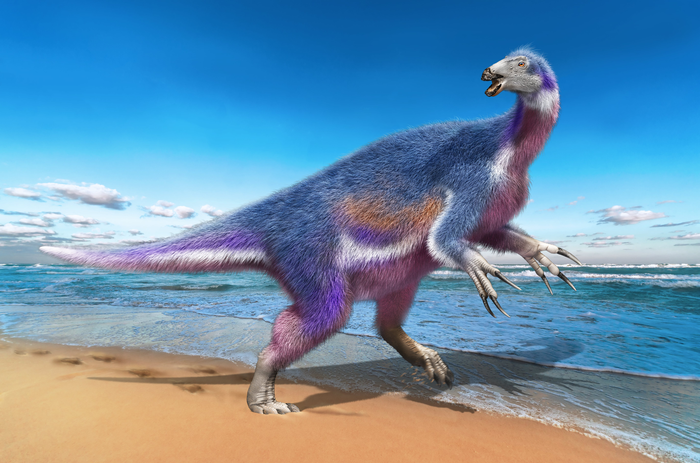
New dinosaur species distinguished by its fearsome claws
A new species of dinosaur has been described by scientists from Japan and the USA. First found in 2008 in the Osoushinai Formation, a fossil-rich geological feature in Nakagawa, Hokkaido, the fossil remains include a partial vertebra, a partial wrist and a front foot with some large claws. At the time of discovery, the specimen was thought to be from a maniraptoran theropod dinosaur, possibly therizinosaur, but not enough evidence existed to confirm this and so its taxonomic status remained unresolved.
In the current study, led by Professor Yoshitsugu Kobayashi at the Hokkaido University Museum and Anthony R. Fiorillo at Southern Methodist University (SMU), the fossil remains have been revisited and analyzed in the light of more recent evidence and knowledge of the therizinosaurid family of dinosaurs. The findings are published in the journal Scientific Reports.
The therizinosauridae (a name meaning ‘scythe lizards’) is a family of theropod dinosaurs characterized by having long necks, thick hind limbs with four-toed feet, large, keratinous beaks and forelimbs with unusually long, curved claws or unguals. It is this last feature that gives the group its name. Their fossils have been found in deposits dated from the Early to the Late Cretaceous Period, distributed widely in Asia and North America. This group of therapods is considered to be herbivorous and closely related to birds.
Asian therizinosaurs have been found mainly from the Cretaceous deposits in Mongolia and China. Japan, which was located at the eastern edge of the Asian continent during the Cretaceous, before the opening of the Japan Sea during the Miocene, has produced two therizinosaur specimens from the Lower and Upper Cretaceous deposits, but neither one has been named because of the difficulty in identifying the fragmentary specimens. The new fossil analyzed in this study is the third, and youngest specimen discovered in Japan.
Asian therizinosaurs had enormous claws on their hands and, based on the morphology of these claws (their length, width at the base, and strength), they are divided into basal therizinosaurs and derived (advanced) therizinosaurs. The basal species have claws that are shorter, stronger and more generalized, implying that they were all-purpose structures not specialized for any particular use. Derived species, in contrast, have some of the longest claws ever recorded in any animals (some measuring 50 cm in length) and these are thought to have specialized functions such as raking taller vegetation towards the mouth as the animal browsed.
The fossil under investigation showed a unique combination of traits in the metacarpal I bone, as well as in the claws, which led the researchers to identify it as a new species of therizinosaur. They named it Paralitherizinosaurus japonicas, which means reaper reptile by the sea from Japan, as its fossilized remains were found in sediments of marine origin. The morphology of its strongly curved claws was compared with that of many other therizinosaur species and the results placed it among the derived therizinosaurs, based on four shared, derived characteristics.
Paralitherizinosaurus japonicus represents the youngest occurrence of therizinosaur remains in Japan. Its discovery indicates that therizinosaurs in Asia existed over a much longer time period, and a much larger geographical area, than previously known. It is also the first therizinosaur record from marine sediments in Asia. Along with a fossil from Utah, USA, this suggests that some of the derived therizinosaurs were adapted to life in coastal environments.
“This study also tells us how much more we still have to learn about the incredible history of life on Earth,” said Fiorillo, a research professor in SMU’s Roy M. Huffington Department of Earth Sciences.
Co-authors of the study include Ryuji Takasaki of Okayama University of Science, Tsogtbaatar Chinzorig of North Carolina State University and Mongolian Academy of Sciences, and Yoshinori Hikida of Nakagawa Museum of Natural History.
Image Credit: Masato Hattori
—
By Alison Bosman, Earth.com Staff Writer












